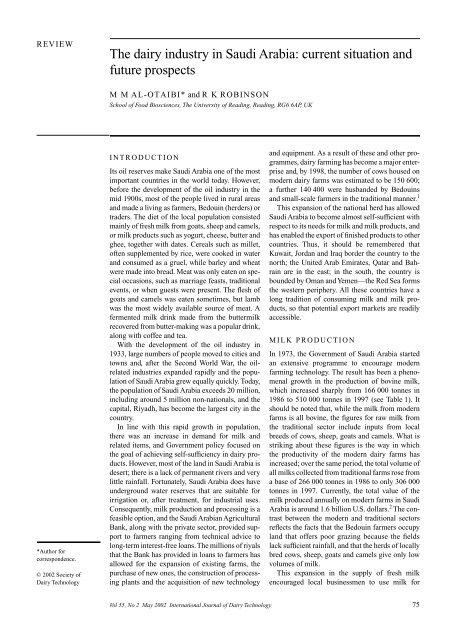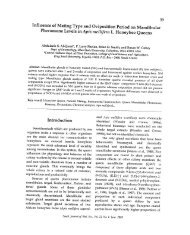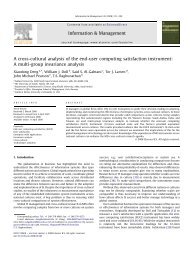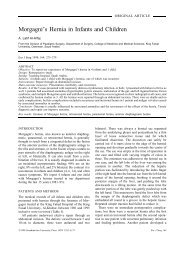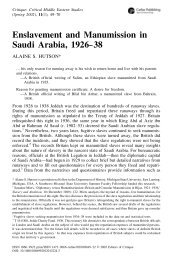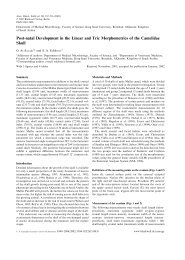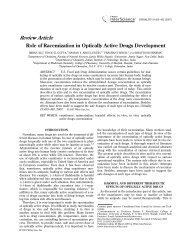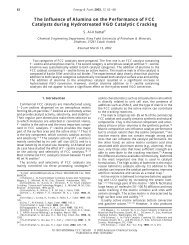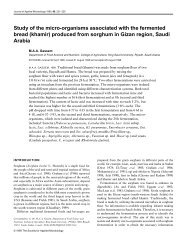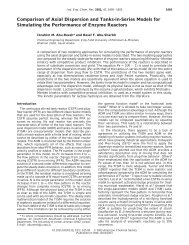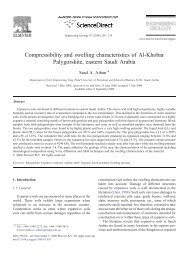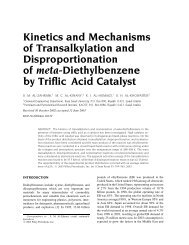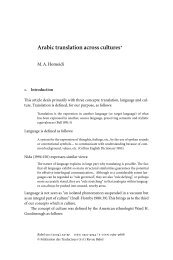The dairy industry in Saudi Arabia: current situation and future ...
The dairy industry in Saudi Arabia: current situation and future ...
The dairy industry in Saudi Arabia: current situation and future ...
Create successful ePaper yourself
Turn your PDF publications into a flip-book with our unique Google optimized e-Paper software.
REVIEW<br />
*Author for<br />
correspondence.<br />
© 2002 Society of<br />
Dairy Technology<br />
Blackwell Science, Ltd<br />
<strong>The</strong> <strong>dairy</strong> <strong><strong>in</strong>dustry</strong> <strong>in</strong> <strong>Saudi</strong> <strong>Arabia</strong>: <strong>current</strong> <strong>situation</strong> <strong>and</strong><br />
<strong>future</strong> prospects<br />
M M AL-OTAIBI* <strong>and</strong> R K ROBINSON<br />
School of Food Biosciences, <strong>The</strong> University of Read<strong>in</strong>g, Read<strong>in</strong>g, RG6 6AP, UK<br />
INTRODUCTION<br />
Its oil reserves make <strong>Saudi</strong> <strong>Arabia</strong> one of the most<br />
important countries <strong>in</strong> the world today. However,<br />
before the development of the oil <strong><strong>in</strong>dustry</strong> <strong>in</strong> the<br />
mid 1900s, most of the people lived <strong>in</strong> rural areas<br />
<strong>and</strong> made a liv<strong>in</strong>g as farmers, Bedou<strong>in</strong> (herders) or<br />
traders. <strong>The</strong> diet of the local population consisted<br />
ma<strong>in</strong>ly of fresh milk from goats, sheep <strong>and</strong> camels,<br />
or milk products such as yogurt, cheese, butter <strong>and</strong><br />
ghee, together with dates. Cereals such as millet,<br />
often supplemented by rice, were cooked <strong>in</strong> water<br />
<strong>and</strong> consumed as a gruel, while barley <strong>and</strong> wheat<br />
were made <strong>in</strong>to bread. Meat was only eaten on special<br />
occasions, such as marriage feasts, traditional<br />
events, or when guests were present. <strong>The</strong> flesh of<br />
goats <strong>and</strong> camels was eaten sometimes, but lamb<br />
was the most widely available source of meat. A<br />
fermented milk dr<strong>in</strong>k made from the buttermilk<br />
recovered from butter-mak<strong>in</strong>g was a popular dr<strong>in</strong>k,<br />
along with coffee <strong>and</strong> tea.<br />
With the development of the oil <strong><strong>in</strong>dustry</strong> <strong>in</strong><br />
1933, large numbers of people moved to cities <strong>and</strong><br />
towns <strong>and</strong>, after the Second World War, the oilrelated<br />
<strong>in</strong>dustries exp<strong>and</strong>ed rapidly <strong>and</strong> the population<br />
of <strong>Saudi</strong> <strong>Arabia</strong> grew equally quickly. Today,<br />
the population of <strong>Saudi</strong> <strong>Arabia</strong> exceeds 20 million,<br />
<strong>in</strong>clud<strong>in</strong>g around 5 million non-nationals, <strong>and</strong> the<br />
capital, Riyadh, has become the largest city <strong>in</strong> the<br />
country.<br />
In l<strong>in</strong>e with this rapid growth <strong>in</strong> population,<br />
there was an <strong>in</strong>crease <strong>in</strong> dem<strong>and</strong> for milk <strong>and</strong><br />
related items, <strong>and</strong> Government policy focused on<br />
the goal of achiev<strong>in</strong>g self-sufficiency <strong>in</strong> <strong>dairy</strong> products.<br />
However, most of the l<strong>and</strong> <strong>in</strong> <strong>Saudi</strong> <strong>Arabia</strong> is<br />
desert; there is a lack of permanent rivers <strong>and</strong> very<br />
little ra<strong>in</strong>fall. Fortunately, <strong>Saudi</strong> <strong>Arabia</strong> does have<br />
underground water reserves that are suitable for<br />
irrigation or, after treatment, for <strong>in</strong>dustrial uses.<br />
Consequently, milk production <strong>and</strong> process<strong>in</strong>g is a<br />
feasible option, <strong>and</strong> the <strong>Saudi</strong> <strong>Arabia</strong>n Agricultural<br />
Bank, along with the private sector, provided support<br />
to farmers rang<strong>in</strong>g from technical advice to<br />
long-term <strong>in</strong>terest-free loans. <strong>The</strong> millions of riyals<br />
that the Bank has provided <strong>in</strong> loans to farmers has<br />
allowed for the expansion of exist<strong>in</strong>g farms, the<br />
purchase of new ones, the construction of process<strong>in</strong>g<br />
plants <strong>and</strong> the acquisition of new technology<br />
<strong>and</strong> equipment. As a result of these <strong>and</strong> other programmes,<br />
<strong>dairy</strong> farm<strong>in</strong>g has become a major enterprise<br />
<strong>and</strong>, by 1998, the number of cows housed on<br />
modern <strong>dairy</strong> farms was estimated to be 150 600;<br />
a further 140 400 were husb<strong>and</strong>ed by Bedou<strong>in</strong>s<br />
<strong>and</strong> small-scale farmers <strong>in</strong> the traditional manner. 1<br />
This expansion of the national herd has allowed<br />
<strong>Saudi</strong> <strong>Arabia</strong> to become almost self-sufficient with<br />
respect to its needs for milk <strong>and</strong> milk products, <strong>and</strong><br />
has enabled the export of f<strong>in</strong>ished products to other<br />
countries. Thus, it should be remembered that<br />
Kuwait, Jordan <strong>and</strong> Iraq border the country to the<br />
north; the United Arab Emirates, Qatar <strong>and</strong> Bahra<strong>in</strong><br />
are <strong>in</strong> the east; <strong>in</strong> the south, the country is<br />
bounded by Oman <strong>and</strong> Yemen—the Red Sea forms<br />
the western periphery. All these countries have a<br />
long tradition of consum<strong>in</strong>g milk <strong>and</strong> milk products,<br />
so that potential export markets are readily<br />
accessible.<br />
MILK PRODUCTION<br />
In 1973, the Government of <strong>Saudi</strong> <strong>Arabia</strong> started<br />
an extensive programme to encourage modern<br />
farm<strong>in</strong>g technology. <strong>The</strong> result has been a phenomenal<br />
growth <strong>in</strong> the production of bov<strong>in</strong>e milk,<br />
which <strong>in</strong>creased sharply from 166 000 tonnes <strong>in</strong><br />
1986 to 510 000 tonnes <strong>in</strong> 1997 (see Table 1). It<br />
should be noted that, while the milk from modern<br />
farms is all bov<strong>in</strong>e, the figures for raw milk from<br />
the traditional sector <strong>in</strong>clude <strong>in</strong>puts from local<br />
breeds of cows, sheep, goats <strong>and</strong> camels. What is<br />
strik<strong>in</strong>g about these figures is the way <strong>in</strong> which<br />
the productivity of the modern <strong>dairy</strong> farms has<br />
<strong>in</strong>creased; over the same period, the total volume of<br />
all milks collected from traditional farms rose from<br />
a base of 266 000 tonnes <strong>in</strong> 1986 to only 306 000<br />
tonnes <strong>in</strong> 1997. Currently, the total value of the<br />
milk produced annually on modern farms <strong>in</strong> <strong>Saudi</strong><br />
<strong>Arabia</strong> is around 1.6 billion U.S. dollars. 2 <strong>The</strong> contrast<br />
between the modern <strong>and</strong> traditional sectors<br />
reflects the facts that the Bedou<strong>in</strong> farmers occupy<br />
l<strong>and</strong> that offers poor graz<strong>in</strong>g because the fields<br />
lack sufficient ra<strong>in</strong>fall, <strong>and</strong> that the herds of locally<br />
bred cows, sheep, goats <strong>and</strong> camels give only low<br />
volumes of milk.<br />
This expansion <strong>in</strong> the supply of fresh milk<br />
encouraged local bus<strong>in</strong>essmen to use milk for<br />
Vol 55, No 2 May 2002 International Journal of Dairy Technology 75
76<br />
Vol 55, No 2 May 2002<br />
Table 1 Increase <strong>in</strong> raw milk production <strong>in</strong> <strong>Saudi</strong> <strong>Arabia</strong><br />
between 1986 <strong>and</strong> 1997; all figures as tonnes × 1000 3 .<br />
<strong>The</strong> figures for the traditional sector <strong>in</strong>clude the milk<br />
from cows, sheep, goats <strong>and</strong> camels, but only bov<strong>in</strong>e<br />
milk is produced by the modern sector<br />
Year Modern Traditional Total<br />
1986 166 266 432<br />
1987 198 252 450<br />
1988 208 243 451<br />
1989 246 229 475<br />
1990 283 233 516<br />
1991 284 236 520<br />
1992 310 238 548<br />
1993 349 238 587<br />
1994 396 237 633<br />
1995 428 270 698<br />
1996 453 296 749<br />
1997 510 306 816<br />
1998 NA NA 883<br />
1999 NA NA 937<br />
2000 NA NA 1039<br />
NA: data not available<br />
process<strong>in</strong>g <strong>in</strong>to products such as cheese <strong>and</strong> butter<br />
<strong>in</strong> order to meet the dem<strong>and</strong> of the local market for<br />
these products. This trend is still cont<strong>in</strong>u<strong>in</strong>g for, as<br />
shown <strong>in</strong> Table 1, the volume of milk produced <strong>in</strong><br />
<strong>Saudi</strong> <strong>Arabia</strong> cont<strong>in</strong>ues to rise. 3,4<br />
DAIRY FACTORIES<br />
<strong>The</strong> <strong>in</strong>dustrial production of liquid milk only began<br />
<strong>in</strong> <strong>Saudi</strong> <strong>Arabia</strong> <strong>in</strong> the 1970s, <strong>and</strong> these first milk<br />
processors fell <strong>in</strong>to two categories. Namely, those<br />
that operated recomb<strong>in</strong><strong>in</strong>g plants work<strong>in</strong>g with<br />
imported milk powder <strong>and</strong> those that h<strong>and</strong>led only<br />
locally produced raw milk. Today the number of<br />
recomb<strong>in</strong><strong>in</strong>g plants has <strong>in</strong>creased dramatically<br />
<strong>and</strong> there are now 17 dairies <strong>in</strong> <strong>Saudi</strong> <strong>Arabia</strong><br />
with recomb<strong>in</strong>ation facilities to produce liquid milk,<br />
or 24 dairies if those us<strong>in</strong>g recomb<strong>in</strong>ed milk for<br />
cheese <strong>and</strong> ice cream production are <strong>in</strong>cluded. 5<br />
However, the market for recomb<strong>in</strong>ed liquid milk<br />
does appear to have slowed (see Figure 1), because<br />
many people prefer the taste of fresh pasteurized<br />
milk if it is available.<br />
To meet this dem<strong>and</strong>, there are now a number of<br />
<strong>dairy</strong> factories with their own farms, <strong>and</strong> factories<br />
that collect raw milk supplies from farms located<br />
throughout the K<strong>in</strong>gdom. <strong>The</strong> majority of these<br />
factories are <strong>in</strong> Riyadh Prov<strong>in</strong>ce (approximately<br />
16 factories), <strong>and</strong> there are 14 <strong>in</strong> the Eastern Prov<strong>in</strong>ce,<br />
eight <strong>in</strong> the Western part of the K<strong>in</strong>gdom, with the<br />
rema<strong>in</strong>der spread across other areas. <strong>The</strong>ir milk<br />
supplies often come from specialized <strong>dairy</strong> farms,<br />
of which there are 24 farms <strong>in</strong> Riyadh Prov<strong>in</strong>ce,<br />
© 2002 Society of Dairy Technology<br />
Figure 1 Comparison between fresh milk <strong>and</strong> recomb<strong>in</strong>ed<br />
milk consumption <strong>in</strong> <strong>Saudi</strong> <strong>Arabia</strong> dur<strong>in</strong>g 1993–1999. 8<br />
seven <strong>in</strong> the Eastern Prov<strong>in</strong>ce, three <strong>in</strong> the northern<br />
part of the K<strong>in</strong>gdom <strong>and</strong> one <strong>in</strong> Najran Prov<strong>in</strong>ce. 4<br />
Many of these farms only supply raw milk to<br />
large-scale processors, <strong>and</strong> there are about eight<br />
processors market<strong>in</strong>g significant volumes of<br />
br<strong>and</strong>ed, commercial <strong>dairy</strong> products. <strong>The</strong>se are<br />
Almarai, Al-Safi, National Agricultural Development<br />
Company (NADEC), Al-Othman, Najdyah,<br />
Al-Matrood, Al-Hana <strong>and</strong> Aziziah. <strong>The</strong>se companies<br />
account for almost all the sales of fresh,<br />
pasteurized milk, <strong>and</strong> have nearly 90% of the<br />
market of laban (a traditional Middle Eastern dr<strong>in</strong>k<br />
similar to a natural dr<strong>in</strong>k<strong>in</strong>g yogurt) <strong>and</strong> 94% of the<br />
market for yogurt.<br />
<strong>The</strong> Al-Safi Dairy holds the dist<strong>in</strong>ction, as well<br />
as a list<strong>in</strong>g <strong>in</strong> the Gu<strong>in</strong>ness Book of World Records,<br />
of be<strong>in</strong>g the largest <strong>in</strong>tegrated <strong>dairy</strong> operation <strong>in</strong><br />
the world. Al-Safi Dairy herds a total of 32 000 cattle<br />
(<strong>in</strong>clud<strong>in</strong>g 24 000 milk<strong>in</strong>g cows) which produce<br />
390 000 L of milk daily <strong>and</strong> 6000 kg of boneless<br />
meat annually. Every stage of the production is<br />
<strong>in</strong>cluded <strong>in</strong> the operation. This covers the grow<strong>in</strong>g<br />
of forage crops under irrigation, breed<strong>in</strong>g programmes,<br />
milk collection <strong>and</strong> process<strong>in</strong>g, packag<strong>in</strong>g<br />
of the f<strong>in</strong>ished products <strong>and</strong> their distribution<br />
to retail outlets. <strong>The</strong> entire operation is h<strong>and</strong>led<br />
on-site at the Al-Safi farm located <strong>in</strong> Al-Kharj about<br />
60 miles south-east of Riyadh. This high degree of<br />
<strong>in</strong>tegration has enabled Al-Safi to atta<strong>in</strong> control<br />
over 30% of the fresh yogurt <strong>and</strong> milk markets <strong>in</strong><br />
<strong>Saudi</strong> <strong>Arabia</strong>. 6<br />
More recently, Danone International acquired<br />
50.1% of the shares <strong>in</strong> <strong>Saudi</strong> Al-Safi Foods—<br />
which own the Al-Safi Dairy—<strong>and</strong> this <strong>in</strong>vestment<br />
should enable the new Al-Safi Danone Company to<br />
enhance its competitive position <strong>and</strong> allow the<br />
company to target the consumers, estimated to be<br />
around 40 million, <strong>in</strong> the neighbour<strong>in</strong>g Gulf States.<br />
<strong>The</strong> Al-Marai <strong>dairy</strong> was orig<strong>in</strong>ally established<br />
with just 1200 Holste<strong>in</strong> Friesian cattle at Al-Kharj<br />
about 60 miles south-east of Riyadh, but today it is<br />
one of the lead<strong>in</strong>g <strong>dairy</strong> companies <strong>in</strong> the K<strong>in</strong>gdom<br />
with over 32 000 head of cattle at its various farms<br />
throughout the region. Before 1996, the company<br />
operated four <strong>dairy</strong> process<strong>in</strong>g plants h<strong>and</strong>l<strong>in</strong>g
Vol 55, No 2 May 2002<br />
fresh raw milk, <strong>and</strong> a cheese blend<strong>in</strong>g plant with a<br />
70 000 litre per day pilot plant used for new product<br />
development. However, <strong>in</strong> 1996, the Company<br />
constructed a factory with a process<strong>in</strong>g capacity of<br />
1.4 million litres of fresh milk per day. 7 <strong>The</strong> Company<br />
now leads the commercial fresh milk <strong><strong>in</strong>dustry</strong><br />
<strong>in</strong> <strong>Saudi</strong> <strong>Arabia</strong> <strong>and</strong> it is the first company to have<br />
treated the Gulf Co-operation Council (GCC)<br />
States as an <strong>in</strong>tegrated market for short shelf-life<br />
products. As a result, it is now a lead<strong>in</strong>g br<strong>and</strong><br />
name <strong>in</strong> five national markets, <strong>and</strong> supplies these<br />
markets with pasteurized milk, laban, yogurt,<br />
cheese, butter, ghee <strong>and</strong> processed cheese. It has<br />
recently <strong>in</strong>troduced its own real fruit laban <strong>and</strong><br />
stirred, real fruit yogurt (<strong>in</strong>clud<strong>in</strong>g a layered fruit<br />
product) <strong>and</strong> it is produc<strong>in</strong>g Yoplait fruit yogurts<br />
under licence.<br />
Other success stories <strong>in</strong>clude the expansion of<br />
NADEC, which has become the third largest <strong>dairy</strong><br />
company <strong>in</strong> <strong>Saudi</strong> <strong>Arabia</strong>. Its farms are stocked<br />
with more than 25 000 cows which give a total production<br />
capacity of 1 million litres per day of fresh<br />
milk.<br />
<strong>Saudi</strong> Danish Dairy Co. (Sadafco) is the largest<br />
importer of milk powder <strong>and</strong>, although it is reconstituted<br />
rather than fresh milk, Sadafco is the<br />
second largest supplier of liquid milk <strong>in</strong> the K<strong>in</strong>gdom.<br />
Its production makes up 19.6% of the total production<br />
of liquid milk <strong>in</strong> <strong>Saudi</strong> <strong>Arabia</strong>, a market<br />
share that puts it <strong>in</strong> second place after Al-Marai.<br />
Jamjoom is another major importer of milk powder<br />
for reconstitution <strong>and</strong> the company has a large<br />
process<strong>in</strong>g plant, located <strong>in</strong> Jeddah, which produces<br />
around 30 million litres of liquid milk per<br />
year. Al-Rabie <strong>Saudi</strong> Dairy Company, based <strong>in</strong><br />
Riyadh is also a significant producer of <strong>dairy</strong> products.<br />
It was established <strong>in</strong> 1980 as a <strong>Saudi</strong>–Irish<br />
jo<strong>in</strong>t venture, <strong>and</strong> now boasts an annual production<br />
of 52 000 tonnes of different products us<strong>in</strong>g reconstituted<br />
milk powder.<br />
Overall, Sadafco, Jamjoom, National Food<br />
Industries, Al-Rabie, Danya, Al-Rai <strong>and</strong> United<br />
Food Industries account for nearly 90% of the production<br />
of <strong>dairy</strong> products from recomb<strong>in</strong>ed milks. 8<br />
MILK PRODUCTS<br />
Over 60% of all bov<strong>in</strong>e milk produced <strong>in</strong> <strong>Saudi</strong><br />
<strong>Arabia</strong> (fresh <strong>and</strong> recomb<strong>in</strong>ed) is fermented <strong>in</strong>to<br />
laban, <strong>and</strong> approximately 25% is pasteurized for<br />
direct consumption as liquid milk. <strong>The</strong> balance is<br />
processed <strong>in</strong>to a yogurt-like product called Zabadi,<br />
Ghishte (a thick ‘spoonable’ cream), labneh (a<br />
concentrated yogurt with around 10% fat), UHT<br />
recomb<strong>in</strong>ed milk with around 3.5% fat (along with<br />
a range of flavoured UHT milks), <strong>and</strong> a wide range<br />
of natural <strong>and</strong> fruit-flavoured stirred <strong>and</strong> set<br />
yogurts. In addition, Unilever has opened a large<br />
ice cream plant <strong>in</strong> the Eastern region of <strong>Saudi</strong><br />
<strong>Arabia</strong> to supply all of the GCC markets, <strong>and</strong><br />
Nestlé has recently taken over the UAE Galadari<br />
ice cream operation. Jamjoom <strong>in</strong> Jeddah makes<br />
Mars milk under licence, while the New Zeal<strong>and</strong><br />
Dairy Board has a jo<strong>in</strong>t venture with Sadafco to<br />
repack Anchor milk powder <strong>and</strong> to produce Chesdale<br />
processed cheese. MD Foods owns Danya <strong>and</strong><br />
produces processed cheese under the br<strong>and</strong> name<br />
‘Puck’, <strong>and</strong> Kraft Foods have <strong>in</strong>volvement <strong>in</strong> the<br />
area as well.<br />
CONSUMPTION<br />
<strong>The</strong> consumption of milk products <strong>in</strong> <strong>Saudi</strong> <strong>Arabia</strong><br />
is gradually <strong>in</strong>creas<strong>in</strong>g <strong>and</strong>, <strong>in</strong> 1999, the total consumption<br />
of liquid milk amounted to 335 million<br />
litres. This figures rises to almost 600 million litres<br />
if laban is <strong>in</strong>cluded. This overall figure gives a per<br />
capita consumption of around 30 L per annum<br />
based on the <strong>current</strong> official estimate of the<br />
population (approximately 20 million). <strong>The</strong> comparative<br />
importance of fresh milk as compared<br />
to recomb<strong>in</strong>ed milk is shown <strong>in</strong> Figure 1.<br />
Canned milk powder (e.g. Nestlé’s NIDO) is still<br />
a very important source of milk <strong>in</strong> most <strong>Saudi</strong><br />
households. In 1999, this usage accounted for a<br />
further 350 million litres of liquid milk equivalent,<br />
suggest<strong>in</strong>g a total underly<strong>in</strong>g market for liquid<br />
<strong>dairy</strong> products of approximately 950 million litres.<br />
As mentioned earlier, a wide range of <strong>dairy</strong><br />
products are manufactured <strong>in</strong> <strong>Saudi</strong> <strong>Arabia</strong>, <strong>and</strong> the<br />
pattern of consumption of some different products<br />
(<strong>in</strong> terms of liquid milk equivalents) is shown <strong>in</strong><br />
Figure 2. Cheese—much of which is imported—is<br />
one of the most popular foods, while ice cream is<br />
<strong>in</strong> least dem<strong>and</strong>.<br />
MARKET TRENDS<br />
Even though imports of milk powder for reconstitution<br />
cont<strong>in</strong>ue (≈ 80 000 tonnes dur<strong>in</strong>g 2000), as<br />
does the importation of pasteurized liquid milk,<br />
Figure 2 <strong>The</strong> <strong>Saudi</strong> <strong>dairy</strong> market <strong>in</strong> 1997. Percentage<br />
consumption. 5<br />
© 2002 Society of Dairy Technology 77
78<br />
Vol 55, No 2 May 2002<br />
Table 2 Development of the <strong>in</strong>ternational trade <strong>in</strong> selected <strong>dairy</strong> products by <strong>Saudi</strong><br />
<strong>Arabia</strong> dur<strong>in</strong>g 1995 <strong>and</strong> 1996 <strong>and</strong> the figures available for 2000; all figures as tonnes 3,9<br />
Import Export<br />
Product 1995 1996 2000 1995 1996 2000<br />
Liquid milk* 2607 3913 NA 28 330 25 354 NA<br />
Fresh cream 1635 2748 NA 86 262 NA<br />
Laban 77 38 93 3090 2394 4112<br />
Yogurt 584 232 134 8997 21 605 2900<br />
Labneh 397 136 1669 872 2640 283<br />
Butter/Ghee 20 065 19 041 14 183 46 81 5.4<br />
Cheese 54 081 49 964 57 082 2893 4290 4703<br />
*Pasteurized milk (fresh <strong>and</strong> recomb<strong>in</strong>ed)<br />
NA: data not available<br />
<strong>Saudi</strong> <strong>Arabia</strong> has not imported any raw milk s<strong>in</strong>ce<br />
the late 1980s. Table 2 shows the pattern of imports<br />
<strong>and</strong> exports for <strong>Saudi</strong> <strong>Arabia</strong> for the period 1995–<br />
1996 <strong>and</strong> 2000, <strong>and</strong> it is clear that the amounts<br />
of fresh cream, yogurt, labneh, butter/ghee <strong>and</strong><br />
cheese be<strong>in</strong>g exported dur<strong>in</strong>g 1995–1996 were on<br />
the <strong>in</strong>crease. This trend suggests that the <strong>dairy</strong><br />
<strong><strong>in</strong>dustry</strong> <strong>in</strong> the K<strong>in</strong>gdom was extremely productive,<br />
<strong>and</strong> that the country had not only reached<br />
self-sufficiency <strong>in</strong> many of the products but had<br />
an excess for export. In 1996, for example, <strong>dairy</strong><br />
exports from <strong>Saudi</strong> <strong>Arabia</strong> to the <strong>Arabia</strong>n Gulf<br />
States totalled nearly 57 000 tonnes.<br />
However, these high levels of export have<br />
not proved to be wholly susta<strong>in</strong>able <strong>and</strong> the<br />
total <strong>dairy</strong> exports from <strong>Saudi</strong> <strong>Arabia</strong> to the<br />
<strong>Arabia</strong>n Gulf States for 2000 decl<strong>in</strong>ed to just<br />
under 30 000 tonnes. Obviously this latter figure<br />
is impressive for a high temperature–low ra<strong>in</strong>fall<br />
country like <strong>Saudi</strong> <strong>Arabia</strong>, but it does suggest that,<br />
© 2002 Society of Dairy Technology<br />
unless there is scope for still further development<br />
of local farms, domestic dem<strong>and</strong> may soon balance<br />
production. Obviously the statistics for 1995/1996<br />
<strong>and</strong> 2000 are not entirely comparable, but the<br />
figures for yogurt <strong>and</strong> labneh illustrate the manner<br />
<strong>in</strong> which <strong>in</strong>creased local dem<strong>and</strong> has dramatically<br />
reduced the export figures for 2000 compared with<br />
just 4 years earlier.<br />
<strong>The</strong>re was, however, an <strong>in</strong>crease <strong>in</strong> the export of<br />
laban <strong>and</strong>, possibly, liquid milk. <strong>The</strong> cont<strong>in</strong>u<strong>in</strong>g<br />
export of cheese probably reflects an expansion <strong>in</strong><br />
the factories produc<strong>in</strong>g Feta-style cheeses from<br />
fresh or recomb<strong>in</strong>ed milks.<br />
REFERENCES<br />
1 Anon (1999) Agriculture Statistical Year Book Issue: 12.<br />
Riyadh, K<strong>in</strong>gdom of <strong>Saudi</strong> <strong>Arabia</strong>: Department of Economic<br />
Studies & Statistics.<br />
2 Anon (1997) Dairy <strong><strong>in</strong>dustry</strong> works toward self-sufficiency.<br />
http://saudiembassy.net/publications/magaz<strong>in</strong>e-spr<strong>in</strong>g-97/<br />
<strong>dairy</strong>.htm.<br />
3 Anon (1998) Production <strong>and</strong> Market<strong>in</strong>g of Dairy <strong>in</strong> K<strong>in</strong>gdom<br />
of <strong>Saudi</strong> <strong>Arabia</strong>. Riyadh, K<strong>in</strong>gdom of <strong>Saudi</strong> <strong>Arabia</strong>:<br />
Department of Economic Studies & Statistics.<br />
4 Anon (2000) Indicators for Agriculture <strong>and</strong> Water <strong>in</strong> K<strong>in</strong>gdom<br />
of <strong>Saudi</strong> <strong>Arabia</strong> Issue: 14. Riyadh, K<strong>in</strong>gdom of <strong>Saudi</strong><br />
<strong>Arabia</strong>: Department of Economic Studies & Statistics.<br />
5 Vickers A (1998) Com<strong>in</strong>g together. Dairy Industries International<br />
63 25–26.<br />
6 Al Safi Foods. <strong>The</strong> World’s Largest <strong>in</strong> Integrated Dairy<br />
Farm. http://www.alsafi.com.<br />
7 Anon (1999) <strong>The</strong> Almarai. European Dairy Magaz<strong>in</strong>e 11<br />
16–17.<br />
8 O’Brien K (2000) Rites of passage. Dairy Industries International<br />
65 27–29.<br />
9 Anon (2000) Import <strong>and</strong> Export Statistics. Riyadh, K<strong>in</strong>gdom<br />
of <strong>Saudi</strong> <strong>Arabia</strong>: M<strong>in</strong>istry of plann<strong>in</strong>g, Central Department<br />
of Statistics <strong>and</strong> Foreign trade.


